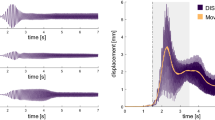Abstract
The validity of electromyographic (EMG) data recorded during whole body vibration (WBV) is controversial. Some authors ascribed a major part of the EMG signal to vibration-induced motion artifacts while others have interpreted the EMG signals as muscular activity caused at least partly by stretch reflexes. The aim of this study was to explore the origin of the EMG signal during WBV using several independent approaches. In ten participants, the latencies and spectrograms of stretch reflex responses evoked by passive dorsiflexions in an ankle ergometer were compared to those of the EMG activity of four leg muscles during WBV. Pressure application to the muscles was used to selectively reduce the stretch reflex, thus permitting to distinguish stretch reflexes from other signals. To monitor motion artifacts, dummy electrodes were placed close to the normal electrodes. Strong evidence for stretch reflexes was found: the latencies of the stretch reflex responses evoked by dorsiflexions were almost identical to the supposed stretch reflex responses during vibration (differences of less than 1 ms). Pressure application significantly reduced the amplitude of both the supposed stretch reflexes during vibration (by 61 ± 17%, p < 0.001) and the stretch reflexes in the ankle ergometer (by 56 ± 13%, p < 0.01). The dummy electrodes showed almost no activity during WBV (7 ± 4% of the corresponding muscle’s iEMG signal). The frequency analyses revealed no evidence of motion artifacts. The present results support the hypothesis of WBV-induced stretch reflexes. Contribution of motion artifacts to the overall EMG activity seems to be insignificant.





Similar content being viewed by others
References
Abercromby AF, Amonette WE, Layne CS, McFarlin BK, Hinman MR, Paloski WH (2007) Variation in neuromuscular responses during acute whole-body vibration exercise. Med Sci Sports Exerc 39:1642–1650
Blottner D, Salanova M, Puttmann B, Schiffl G, Felsenberg D, Buehring B, Rittweger J (2006) Human skeletal muscle structure and function preserved by vibration muscle exercise following 55 days of bed rest. Eur J Appl Physiol 97:261–271
Burke D, Hagbarth KE, Lofstedt L, Wallin BG (1976) The responses of human muscle spindle endings to vibration of non-contracting muscles. J Physiol 261:673–693
Cochrane DJ, Stannard SR (2005) Acute whole body vibration training increases vertical jump and flexibility performance in elite female field hockey players. Br J Sports Med 39:860–865
De Ruiter CJ, Van Raak SM, Schilperoort JV, Hollander AP, de Haan A (2003a) The effects of 11 weeks whole body vibration training on jump height, contractile properties and activation of human knee extensors. Eur J Appl Physiol 90:595–600
De Ruiter CJ, van der Linden RM, van der Zijden MJ, Hollander AP, de Haan A (2003b) Short-term effects of whole-body vibration on maximal voluntary isometric knee extensor force and rate of force rise. Eur J Appl Physiol 88:472–475
Fratini A, Cesarelli M, Bifulco P, Romano M (2009) Relevance of motion artifact in electromyography recordings during vibration treatment. J Electromyogr Kinesiol 19:710–718
Gollhofer A, Rapp W (1993) Recovery of stretch reflex responses following mechanical stimulation. Eur J Appl Physiol Occup Physiol 66:415–420
Gruber M, Taube W, Gollhofer A, Beck S, Amtage F, Schubert M (2007) Training-specific adaptations of H- and stretch reflexes in human soleus muscle. J Mot Behav 39:68–78
Kvorning T, Bagger M, Caserotti P, Madsen K (2006) Effects of vibration and resistance training on neuromuscular and hormonal measures. Eur J Appl Physiol 96:615–625
Leukel C, Lundbye-Jensen J, Zuur AT, Gruber M, Gollhofer A, Taube W (2009) Short-term pressure induced suppression of the short latency response—a new methodology for investigating stretch reflexes. J Appl Physiol 107:1051–1058
Matthews PB (1966) The reflex excitation of the soleus muscle of the decerebrate cat caused by vibration applied to its tendon. J Physiol 184:450–472
Mester J, Spitzenpfeil P, Yue Z (2002) Vibration loads: potential for strength and power development. In: Komi P (ed) Strength and power in sport, 2nd edn. Blackwell, Oxford, pp 488–501
Mileva KN, Bowtell JL, Kossev AR (2009) Effects of low-frequency whole-body vibration on motor-evoked potentials in healthy men. Exp Physiol 94:103–116
Rittweger J, Beller G, Felsenberg D (2000) Acute physiological effects of exhaustive whole-body vibration exercise in man. Clin Physiol 20:134–142
Rittweger J, Mutschelknauss M, Felsenberg D (2003) Acute changes in neuromuscular excitability after exhaustive whole body vibration exercise as compared to exhaustion by squatting exercise. Clin Physiol Funct Imaging 23:81–86
Roll JP, Vedel JP, Ribot E (1989) Alteration of proprioceptive messages induced by tendon vibration in man: a microneurographic study. Exp Brain Res 76:213–222
Stein E, Shakarchi R (2003) Fourier analysis: an introduction. Princeton University Press, Princeton
Torvinen S, Sievanen H, Jarvinen TA, Pasanen M, Kontulainen S, Kannus P (2002) Effect of 4-min vertical whole body vibration on muscle performance and body balance: a randomized cross-over study. Int J Sports Med 23:374–379
Author information
Authors and Affiliations
Corresponding author
Additional information
Communicated by Arnold de Haan.
Rights and permissions
About this article
Cite this article
Ritzmann, R., Kramer, A., Gruber, M. et al. EMG activity during whole body vibration: motion artifacts or stretch reflexes?. Eur J Appl Physiol 110, 143–151 (2010). https://doi.org/10.1007/s00421-010-1483-x
Accepted:
Published:
Issue Date:
DOI: https://doi.org/10.1007/s00421-010-1483-x




